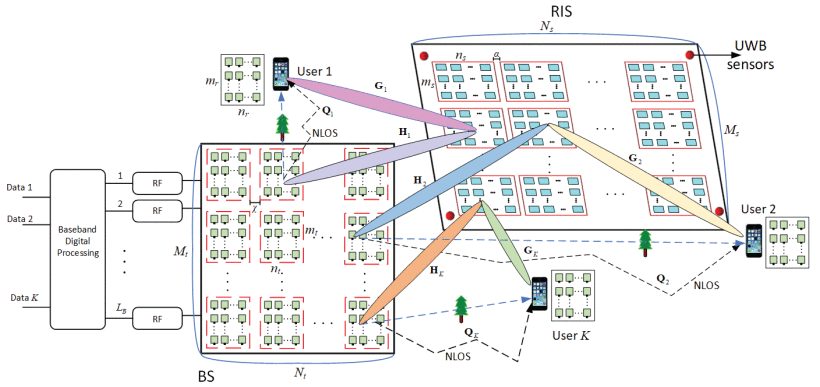Joint Hybrid 3D Beamforming Relying on Sensor-Based Training for Reconfigurable Intelligent Surface Aided TeraHertz-Based Multiuser Massive MIMO Systems
The Terahertz (THz) era is upon us, promising blazing-fast internet speeds that could revolutionize how we connect and communicate. The need for faster data rates in wireless communications has surged due to the rapid expansion of mobile devices and seamless multimedia applications. THz technology operates at frequencies much higher than current Wi-Fi, which means it can carry data incredibly fast. However, these signals have trouble getting through obstacles and weaken over distances.
To tackle these issues, the authors propose using Reconfigurable Intelligent Surfaces (RIS) – think of these as smart mirrors that can bend and direct internet signals precisely where they need to go. This helps THz waves avoid obstacles and maintain their strength over longer distances.
The system also incorporates a Massive Multiple Input Multiple Output (MIMO) approach. Imagine having multiple Terahertz channels your router can choose from, so even in a crowded apartment building, your signal doesn't get drowned out by the neighbors. MIMO lets multiple users enjoy high-speed connections without stepping on each other's digital toes.
Terahertz (THz) waves, characterized by their short wavelengths, produce highly focused beams that are challenging to align accurately for optimal signal transmission in THz communication systems. The system uses Ultra-wideband (UWB) sensors to improve the efficiency of the beam training algorithm. These are like indoor GPS that help the network pinpoint exactly where your devices are, adjusting the signal to follow you as you move from room to room.
The RIS can be deployed on building walls, facades, and unmanned aerial vehicles (UAVs) to support 3D passive beamforming. Integrated with UWB sensors, the RIS utilizes user location information for channel estimation and beamforming.
In a novel joint hybrid 3D beamforming approach, the system integrates BS array-of-subarray with a corresponding sub-RIS architecture for RIS-aided THz multi-user massive MIMO systems.
In a clever twist, the system combines active and passive beamforming – essentially, it's a dual approach where both the base station (like your router) and the RIS smartly adjust their signals for the best connection. This means your video call won't freeze just because someone else started streaming a movie.
This new tech significantly upped the network's efficiency when put to the test. In MATLAB simulations, our sensor-based method outperforms the original system in far-field scenarios. Near-field results show higher spectral efficiency, suggesting potential for improved THz communication with additional RIS elements. Compared to systems without these innovations, it showed up to a 10% increase in spectral efficiency – that's tech-speak for "it can transmit more data without needing more radio waves."
In plain terms, this is a huge leap forward. It's not just about speed; it's about stable, reliable connections wherever you are – at home, in a cafe, or at the office. The authors are paving the way for a future where our online experiences are seamless, and this THz technology is a key piece of that puzzle. With it, the internet could become faster, more reliable, and more accessible to everyone, everywhere.




